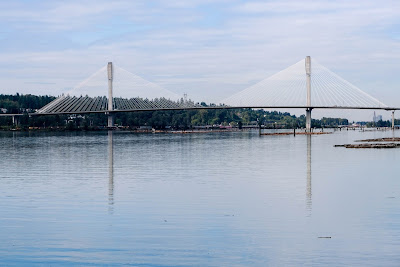While no decisions were made a last night’s Langley City council meeting, the agenda was dense with updates from community organizations and our municipality’s departments.
Before council heard the updates, two long service awards were presented to Langley City staff members.
 |
| Mayor presenting long service awards to Langley City staff members. Select image to enlarge. |
The first presentation heard by council was for Canuck Place Children’s Hospice. Katrine Chow, who represented the organization, outlined the services they provide, and the number of families they help. As an example, in 2016, 715 families were helped by their programs with 44% of families coming from the Fraser Valley. 20 families lived in Langley. Most children are in their programs for 3 years. Chow also invited council to attend their Gift of Love Gala which is schedule for Saturday, February 17, 2018.
The next update from the Downtown Langley Business Association/Discover Langley City was presented by Teri James. She reviewed the 2017 McBurney Summer Series and Duelling Pianos Evening events. Both the daytime events and evening event were successful. Duelling Pianos in the Plaza, a 19+ event, was sold out within four days.
For 2018, James outlined that they will be focusing on bringing high-quality entertainment for families during the day, and will be hosting an additional 19+ evening event with high-quality entertainment. Bringing positive evening activities to our downtown core is something that I believe is critically important. Not only does it help build community, but it also reduces negative activities in the evening.
Between the McBurney Plaza Summer Series and other events, there will be something going on pretty much every weekend next summer in our community’s core.
June 23: McBurney Plaza Summer Series — Day
July 7: McBurney Plaza Summer Series — Day
July 14: McBurney Plaza Summer Series — Evening
July 28: McBurney Plaza Summer Series — Day
August 11: McBurney Plaza Summer Series — Evening
August 18: 25th Annual Arts Alive Festival
August 25: Fork and Finger Event
As was reported this summer, planning for a night market is still in the works for 2018 which will bring even more positive activity to our downtown in the evening.
Later in the presentation, James introduced Melissa Phillips who is heading up Discover Langley City, our new destination marketing organization. Phillips comes from Richmond Tourism.
Rick Bomhof, Director of Engineering, Parks & Environment, updated council on the activities in his departments.
In 2017, council approved additional funding for an on-going corridor improvement program. Bomhof shared some pictures of the enhancements that were funded via the program.
 |
| Example of street improvement on 53 Avenue near 203 Street. Select image to enlarge. |
 |
| Example of enhanced sidewalk maintenance in Downtown Langley. Select image to enlarge. |
Bomhof also noted that work is almost completed in Hunter Park. For more information, please visit the City’s website.
Another major project is the 200th Street Bridge deck replacement. This project is scheduled to be completed in the next few weeks.
Other projects on-the-go include:
- New Baldi Creek corrugated steel culverts for better fish passage
- 53/51B Avenue bike lanes
- Ongoing road patching and repaving
- Spray park expansion at City Park
- 56 Avenue Project: Glover Rd to Langley Bypass
- 48 Avenue sewer replacement
- Culvert relining on Fraser Highway near Production Way
- Langley Bypass culvert replacement
- Rotary Park sports field upgrades
- New Penzer Park washroom & picnic shelter
Our City crews have been, and continue to be, extremely busy making our community awesome.
Tomorrow, I will be posting about the remaining topics covered at Monday night’s council meeting.








































